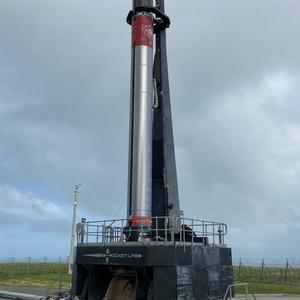Commercial rideshare mission including payloads for Alba Orbital, Astrix Astronautics, Aurora Propulsion Technologies, E-Space, Spaceflight Inc, Swarm Technologies and UNSEENLABS.
Electron is a two-stage orbital expendable launch vehicle (with an optional third stage) developed by the American aerospace company Rocket Lab. Electron is a small-lift launch vehicle designed to launch small satellites and cubesats to sun-synchronous orbit and low earth orbit. The Electron is the first orbital class rocket to use electric-pump-fed engines, powered by the 9 Rutherford engines on the first stage. It is also used as a suborbital testbed (called HASTE) for hypersonics research.
See Details
Rocket lab successfully caught the Electron first stage, however due to different load characteristics than were experienced during testing the pilot dropped the stage at his discretion to complete a successful splashdown.
Result: 26 did not land successfully.Rocket Lab is an American aerospace manufacturer with a wholly owned New Zealand subsidiary. The company develops lightweight, cost-effective commercial rocket launch services. The Electron Program was founded on the premise that small payloads such as CubeSats require dedicated small launch vehicles and flexibility not currently offered by traditional rocket systems. Its rocket, the Electron, is a light-weight rocket and is now operating commercially. The company is also producing a variety of spacecrafts and spacecrafts components.
INFO WIKIRocket Lab used a helicopter to capture a spent Electron first stage booster and its parachute after launching satellites from New Zealand Monday, a significant step forward for the company’s rocket recovery and reuse program. The helicopt…
"It's kind of like Ghostbusters in some way."
In a significant achievement, public launch provider Rocket Lab has – with a few caveats – successfully used a helicopter to catch...
Rocket Lab declared success in its effort to catch an Electron booster in midair after launch May 2, even though the helicopter had to release the booster moments later.
After announcing plans to recover and reuse the first stage of the company’s Electron rocket back in 2019, the California-based rocket company has attempted a mid-air recovery for the very first time. After a successful mid-air catch, the …
Gaofen is a series of civilian Earth observation satellites developed and launched for the China High-definition Earth Observation System (CHEOS), a …
A batch of 20 satellites for the Starlink mega-constellation - SpaceX's project for space-based Internet communication system.
3 weather satellites performing atmospheric measurements using GNSS Radio Occultation for a Tianjin based company. Constellation is planned to have a…
Maiden Flight of the Ariane 62 launch vehicle, carrying ten cubesats, two deployers, five experiments, and two reentry capsules.
Türksat 6A is Turkey's first domestically manufactured geostationary communications satellite. It is to reside in 42° East orbital slot, providing se…
A pair of satellites officially described as for cartographic surveying purposes, details TBD.
Fifth flight of the Firefly Alpha small sat launcher, carrying eight cubesats for NASA's ELaNa 43 (Educational Launch of a Nanosatellite) mission.
A batch of 20 satellites for the Starlink mega-constellation - SpaceX's project for space-based Internet communication system.
The Advanced Land Observing Satellite-4 (ALOS-4) is a Japanese satellite designed to observe the Earth's surface using a phased array type L-band syn…
Chinese communication geostationary satellite for unknown purposes.